For those that have visited my site in the past, you may have browsed the ExtremeAire compressor write-up I did when MikeW and I put his ExtremeAire compressor in his TJ. Mike has had his unit for a couple of years and last I knew, it was still going strong. Another local friend has used his ExtremeAire for several years and I know for certain he has used the heck out of it. When I discovered that another friend of mine, DonP, was selling his ExtremeAire (he was upgrading to the new Warn winch/compressor unit), we settled on a price and I stopped by his house to retrieve it once he got it out of his Rubicon.
There is always a couple of ways to skin a cat, for the most part, so I thought another write-up on this compressor could be useful. Aside from the compressor, most everything I was doing was different from MikeW’s setup so now you will have a 2nd opinion on how to install the ExtremeAire compressor and interface it into your TJ.
I visited Extreme Outback’s web site to see if I could gather some info on the compressor. The following specs are from their site:
– Continuous duty cycle
– 3/4 horsepower motor
– 30-amp draw at 35psi
– 40-amp draw at 150psi
– 4 cfm free flow rate
– 150psi max working pressure
– Can be mounted upside down
– 14″ long, 6″ wide, 9″, tall
I was hoping to find a flow rate with rated pressure as this provides more info as to how well the compressor performs under real world conditions such as airing up a tire to 30 PSI. I’ll post some air-up times once everything is checked out.
For what it is worth, I called the phone number on the web site and spoke with GeorgeC, a very pleasant gentleman who answered the phone. I explained to GeorgeC that I was the second owner of this compressor, having just bought it from a friend, and that I was preparing to install it. My question…..”What is the proper gauge wire to use during installation.” Since I didn’t have the owner/install manual, I thought this was a legitimate question. GeorgeC inquired as to my installation and the distance between the compressor and the battery. After telling him it would be about an 8′ run of wire, he informed me that I should stick with 8 gauge wire or even use 6 if I could find it. George stated that if I was mounting the compressor near the battery, 10 gauge would be sufficient. He also suggested I install a one-way check valve (more on that later). I thanked him for his time and he said that if I had any other questions come up during the install, I should give him a call. Nice guy….good customer service. Thanks GeorgeC!

Included with the compressor was the control solenoid that Extreme Outback sells as well as their 100 amp circuit breaker. Thanks Don for tossing in those extra items! As the saying goes, the devil is in the details, and so it is with many Jeep projects. Having the control solenoid and a suitable circuit breaker already in hand made this project that much easier. I did a quick check of my electrical parts box and noticed I would need a few connectors for the 8 gauge wire. The rest of the odds and ends were either already installed in the TJ or were sitting on my parts shelf. On with the installation!
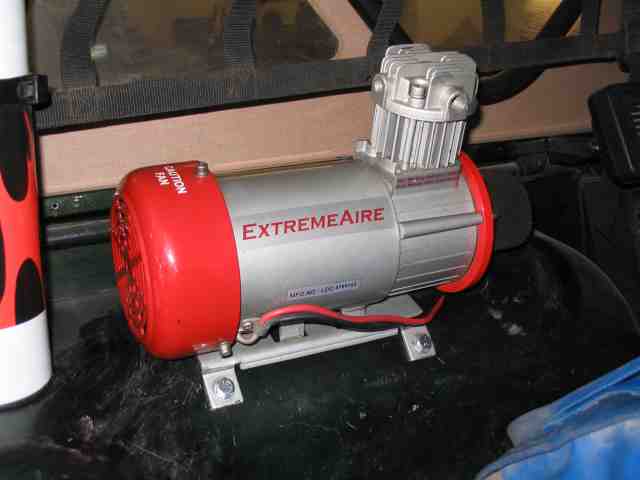
Since I already had my air tank mounted on the passenger side fender in the rear of the TJ, I opted to put the air compressor on the driver’s side fender. The ExtremeAire has four tabs, or feet, on the mounting bracket. After looking at the mounting location (it was not completely flat) for a bit and thinking about how we had done MikeW’s mounting, I realized that I could bend the mounting tabs a small amount. By doing do, they would conform to the contoured fender surface without the need for any additional brackets. I placed the compressor on the work bench and let the tabs (on one side) hang over the edge. A little gentle persuasion with a hammer was all it took to move them into a suitable position. Easy enough and no extra hardware needed!
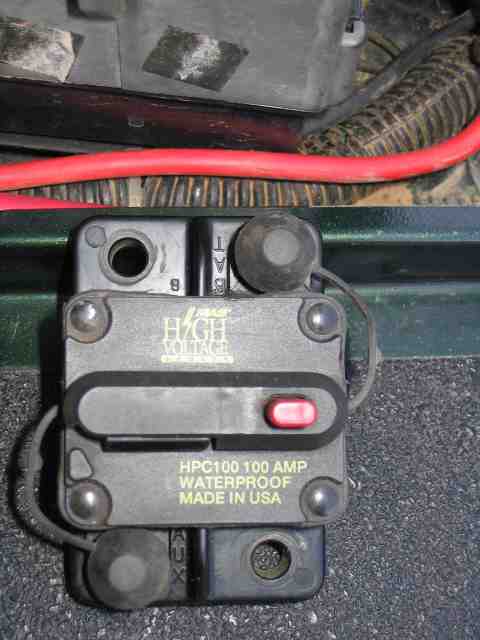
With the ExtremeAire bolted onto the driver’s side rear fender, it was time to see what I could do under the good. I already had a run of 8 gauge wire going to the rear of the TJ (which would need to be extended by a few feet as I later discovered) that started near the factory fuse box. I got the waterproof circuit breaker from DonP out of the box and cleaned it up a bit. As you can see, it is rated for 100 amp. Pushing the red button causes the breaker to trip. You can reset it by pushing the trip arm back into position. The terminals on the circuit breaker are clearly marked for the battery and load connections.
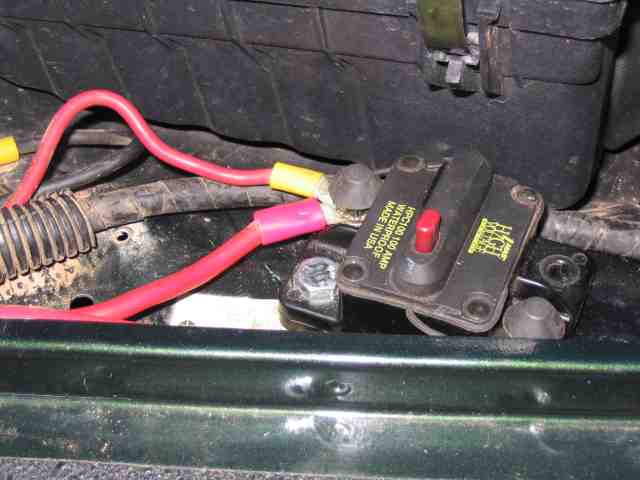
I recycled a mounting hole from some other project and bolted the circuit breaker into position. The 8 gauge wire was connected to the AUX terminal on the breaker. I made a 10″ long 8 gauge jumper and routed it from the remaining terminal on the breaker to the suck down winch controller for an easy positive terminal battery connection (not shown in this photo). It was easier than running the cable back to the battery and kept the clutter away from the battery terminals at the same time.
ExtremeAire Compressor Installation
A few days have gone by (had to go to work) and it is now Saturday morning. I needed some 8 gauge wire to finish the power run to the compressor. Several visits to the nearby NAPA, AutoZone, and ACE Hardware left me looking at 10 gauge wire but no #8. I stopped at an automotive audio store located near my house and found what I needed. They had 8 gauge wire for 99 cents a foot. I bought 10 feet and a few ring terminals and headed for home.
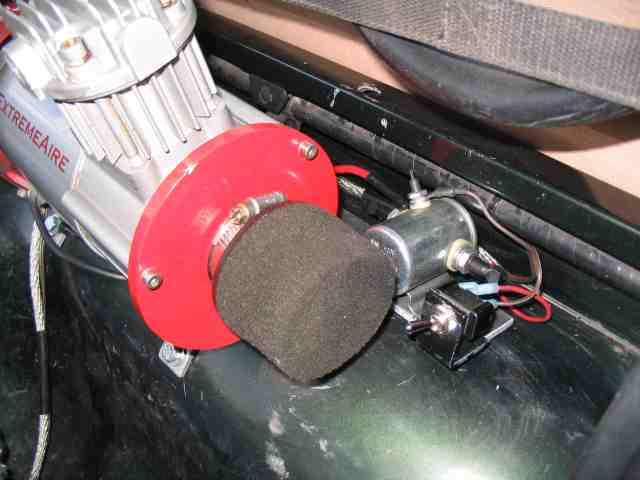
I recycled a piece of scrap aluminum that was in the garage for a mounting plate. The power solenoid and control switch was mounted on the plate and the plate then bolted to one of the bolts holding the ExtremeAire in place. This was a quick and easy method to get everything up and running as I have a trail run coming up shortly and wanted to try the new compressor. I’ll use another Saturday morning to replace the power switch with one from my bank of switches up on the center console. This will make it easier to power on/off the compressor from the driver’s seat and help reduce the random placement of switches my TJ seems to accumulate.
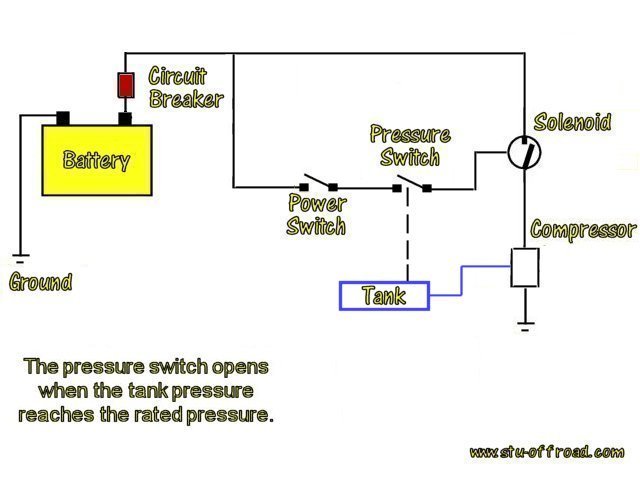
The wiring diagram for controlling the compressor is pretty straight forward. Let’s see how it works.
1. Let’s start with the tank empty (no air in the sytem).
2. The pressure switch will then be closed when there is no air in the tank.
3. When we close the power switch (turn it on), +12 volts is applied to the power solenoid.
4. The solenoid energizes and applies +12 volts to the compressor which turns it on.
5. When the tank pressure reaches the pressure switch’s rated pressure, the pressure switch opens.
6. The open switch deenergizes the solenoid which turns off the compressor even though the power switch is still on.
I used an ARB pressure switch (the spare I had) to control tank pressure. I can now use this system to run my ARB air lockers if I wish as the lockers will be supplied with the correct air pressure, just as if it were coming from the ARB compressor.
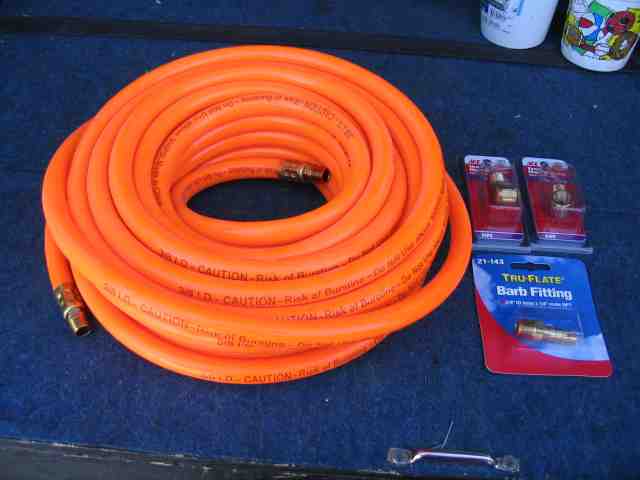
I thought I had some air hose tucked away in the garage but it must have gone out in the one of the cleaning sessions some time ago. A quick trip to the ACE Hardware store to acquire some 3/8″ hose, a couple of 90 degree 1/4″ NPT elbows, and a 1/4″ NPT hose barb fitting and I was ready to go. I’m not sure how this PVC hose will hold up to the temps coming out of the compressor. If it suffers a melt down, I’ll pick up some Goodyear rubber hose from another store I was shopping in a couple of weeks ago.
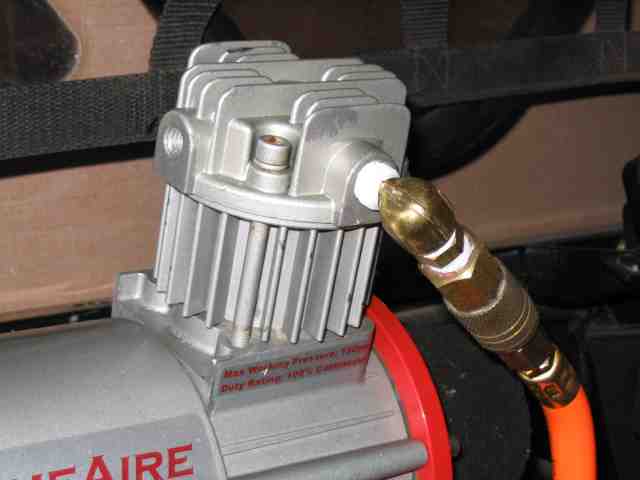
With some Teflon tape applied to the male threads of the 90 degree elbow, I screwed it into the compressor head. To the elbow, I attached a female quick disconnect air fitting. I used the manufacturer installed fitting on the end of the hose to attach it to a male quick disconnect air fitting. This setup allows me to disconnect the air line going from the ExtremeAire compressor to the air tank, just in case an issue arises that requires the compressor to be disconnected from the rest of the OBA system.
 The air tank received the remaining 90 degree elbow and the 3/8″ hose barb was screwed into it after both fittings were wrapped with Teflon tape.
The air tank received the remaining 90 degree elbow and the 3/8″ hose barb was screwed into it after both fittings were wrapped with Teflon tape.
A test run with the plumbing installed yielded promising initial results. The compressor ran for a bit an then shut itself off when the tank’s pressure switch opened the power solenoid circuit. So far, so good.
It was time to see just how well the ExtremeAire compressor was going to work. I attached a tire deflator to the valve stem on one of my 35″ Goodyear MT/R tires and took it down to exactly 10 PSI.

I clicked on the stop watch mode on my wrist watch and started timing the air up. I stopped once at 1:30 and had about 25 pounds of pressure. The air chuck went back onto the valve stem and the timing was continued.
At 2 minutes, I stopped the tire filling and checked the tire pressure again. It was right on 30 PSI. I was pretty satisfied with these results. My recently retired QuickAir 2 would normally fill a 35″ tires in about 5 minutes, so the ExtremeAire compressor is looking good. My end of trail air-ups have been reduced to 10 minutes which includes getting the air hose out and putting it away. I already like the sound of that.
I’m waiting for the one-way valve to show up in the mail. When it arrives, I’ll update this write-up and then this one will be finished. Nothing was shipped this past week due to everyone being at the SEMA show.
Good trails and remember to TREADLightly!
ExtremeAire Compressor Installation
Update: 11/9/2006
The check valve from Extreme Outback arrived mid-week. I had gotten an e-mail from George earlier in the week stating that they had mistakenly missed notifying me (of the SEMA induced delay) about my order and offered to ship the order for free. I responded that it was not necessary but when the valve arrived, the invoice showed free shipping. Thanks Extreme Outback for great customer service!
The check valve is a one way valve. Air can flow through the valve in one direction but is blocked from flowing in the opposite direction. The check valve is installed between the output port of the compressor and the air tank such that the air can flow out of the compressor but not back into it. This is done so that once the air tank is filled and the pressure switch turns off the compressor, air in the tank can not leak back into the compressor and bleed down the tank. It also allows pressure in the compressor cylinder to bleed off (naturally) which makes it much easier for the motor to start later on since it has no head pressure to push against.

The check valve allows air flow in the direction of the arrow that is stamped on one of the wrench flats. Be sure you pay attention to which way your install the valve. Putting it in backwards (against the air flow) will certainly cause much grief for your compressor (and possible damage). The valve comes with a brief instruction sheet that cautions against over tightening the end with the white plastic X. Too much and it will break the valve. I used Teflon tape on both ends of the check valve.
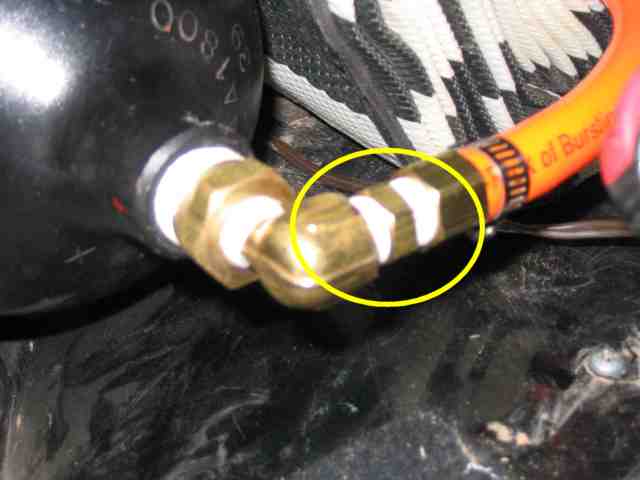
As with the other air fittings, I applied Teflon tape to both sets of threads on the check valve. I removed the 3/8″ hose from the 90 degree elbow at the inlet of the air tank and threaded the check valve into the elbow. I then threaded a female air hose barb fitting onto the check valve. The air hose was slipped onto the barb fitting and a small hose clamp was used to secure the hose in place.
After the tank was filled, I disconnected the compressor’s end of the hose. I couldn’t detect any air flowing out which meant the check valve was working. An overnight test revealed that it did indeed work very well. The tank was still full when I checked it.
